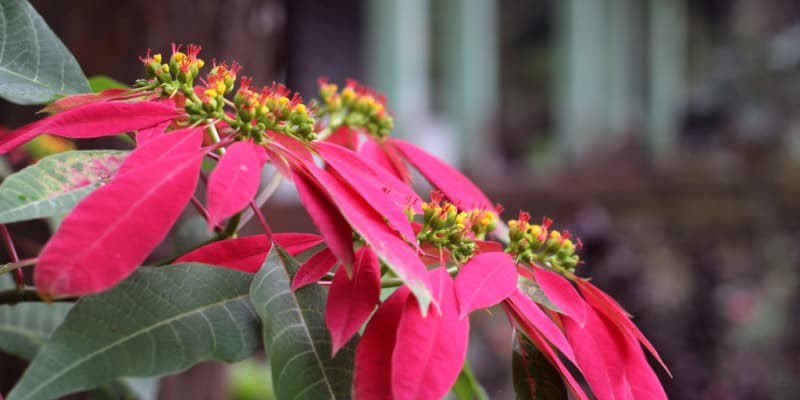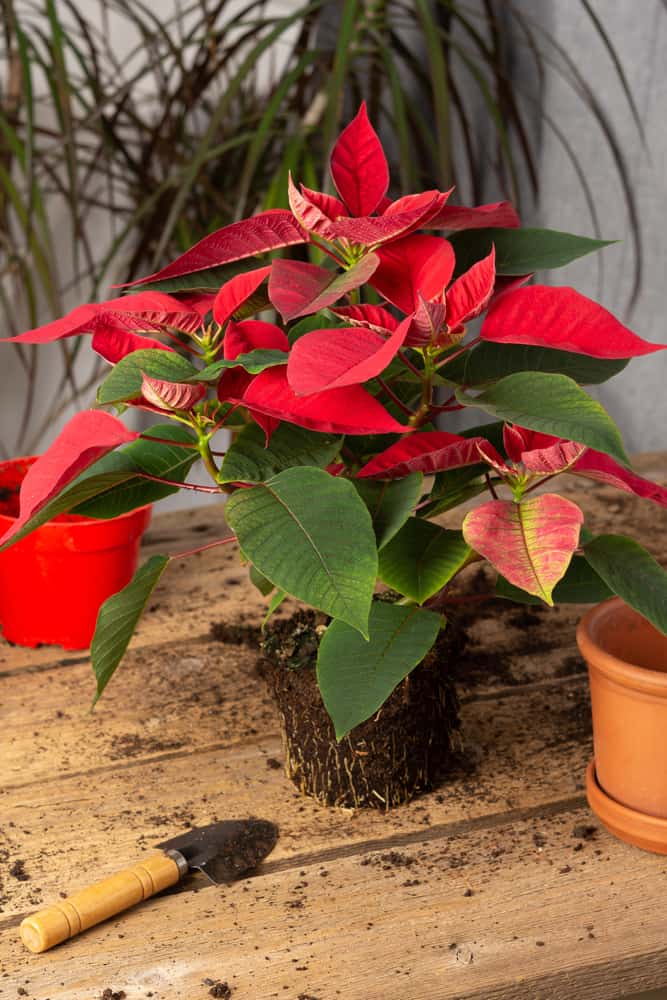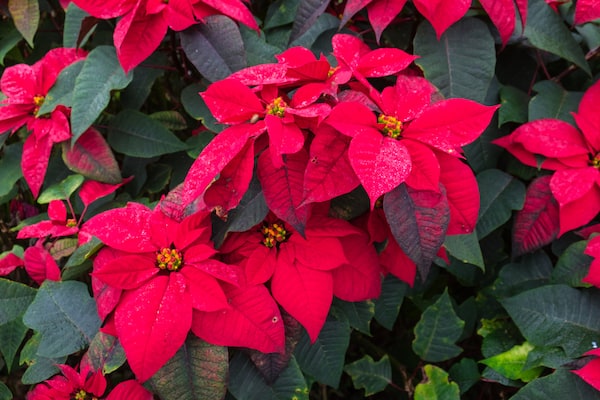
How to get poinsettias to turn red again?
Our site is reader supported, this means we may earn a small commission from Amazon and other affiliates when you buy through links on our site.
Once your poinsettia has finished blooming for the winter holiday season, don’t throw it away. With some care and attention, you can keep it through the next year so that the poinsettia turns red again the next winter. Best of all, you will be rewarded with an bigger and more impressive poinsettia the following Christmas.
Here are the things you have to do to it in the different seasons, including keeping it moist, pruning it and transplanting it into the garden for a while (although you can skip that last bit if you want). It’s quite a bit of work, so don’t feel bad if you just want to buy another poinsettia instead but for hobby gardeners, it can bd very rewarding.
January to April – Start feeding every few weeks
Keep to the regular watering schedule for your poinsettia. So water it whenever the surface of the soil feels dry. Towards the end of this period, start fertilising it every few weeks. Use a general all-purpose houseplant fertiliser to give the plant all-round nutrition.
Side shoots develop below the bracts (coloured leaves) and grow up above the old stems. This is OK, but you can prune the old plant back so that you have a well-shaped plant for the new growth. In early March or so, cut back the old growth to about 10cm to 15cm in height, leaving one to three leaves on the old branches. This causes the new growth to develop from the buds.
Keep the plant in a sunny place so that growth happens. Poinsettia like temperatures of around 15˚C to 20˚C, this is important. Add some more soil to the pot. A commercial sterile compost mix is a good choice.
Then cut back the watering a bit. After a week or two of this drier regime, move the plant to a cooler place of about 15˚C. For me this is the dining room as it always cooler in there.
Also keep and eye out for curling leaves on your poinsettia or yellow and wilting poinsettia leaves as this is a sign that the care is not quite right.
May to June – Repot and prune
In May it’s time to prune the new stems but its also a great time to take poinsettias cuttings too. Cut them back to 10cm to 15cm above the soil. As the plant’s grown quite a bit by now, repot it in a slightly larger container. Use new potting soil or sterile compost to give it a boost of new nutrients. Move the plant in its new pot back to a sunny windowsill and a slightly higher temperature of 18˚C to 23˚C. Go back to watering the plant when the top of the soil feels dry.
Keep a look out for any new growth. That’s the time to begin fertilising every fortnight with the same complete fertiliser as before. You want to make sure that the poinsettia gets a well-rounded supply of nutrients.
June’s the time to move the poinsettia outdoors, but only once any chance of frost has passed. It should also be above 10˚C throughout the night time, so this will depend on your local weather. I personally keep my poinsettias indoors. As these plants don’t like direct sunlight light, place the pot in a slightly shaded area, away from winds. Potted plants outdoors dry out quickly, so keep an eye on the moisture at the top of the soil in the pot and water when dry. As the plant grows, apply fertiliser more frequently to help the growing foliage. If the plant is getting tall and spindly, pruning off some of the height will encourage it to branch out to the sides.
Whilst growing poinsettias as a house plant they can get the usual poinsettia pest and diseases so be on the look out for these and treat early.
July to August – Time to start pinching out the stems
July’s the best time to really shape your plant. Pinch about 3cm off each stem. This encourages the plant to become well-branched rather than straggly and tall. Move the plant into a sunnier spot but watch that the leaves don’t become scorched. Continue to water and fertilise the plant. You may want to increase the frequency at which you apply the fertiliser to help with growth, but don’t overdo it.
By mid-August, the stems should look pleasing and the leaves appear. Once again, prune the new stems, leaving three to four leaves per shoot in place. Carry on with your watering and fertilising plan.
September to November – Time to bring them indoors and reduce feeding
Stop pruning at the beginning of September when you bring the poinsettia back indoors. Find it a sunny location inside with at least six hours of sunlight daily. The best temperature to keep it in is 18˚C to 23˚C so for me the living room is perfect. Start to reduce the amount of fertiliser in preparation for the plant’s dormant period but continue the watering regime.
This bit is super important, don’t skip this step
At the beginning of October, you need to start putting your poinsettia into complete darkness for part of the 24-hour period. This inhibits the amount of (green) chlorophyll developing in the bracts and allows the colour to develop. The plant needs 13 hours of uninterrupted darkness per 24-hour period, followed by 11 hours of bright sunlight.
This means putting the poinsettia in a closet, basement or under a box, and not turning on a light or lifting up the box in the 13-hour time period. Make sure the temperature in the dark period is around 15˚C. Complete darkness is needed – 13 hours every 24-hour period from October until the colour develops. Water as needed and fertilise weekly until the coloured bracts develop. That’s quite a commitment of care on your part.
Sometime in late November, the colour develops on the bracts and the poinsettia starts to turn red. You can stop the day/night routine at this point. Move the plant back to its sunny location for at least six hours of sunlight. Reduce the watering and fertilising schedule. Look closely and you can see flower buds at this time.
December
Stop fertilising the poinsettia around the middle of December. Keep watering when the top of the soil is dry. The poinsettia should turn red (or its original colour) and be in bloom at this point. And you’re ready to start all over again.

